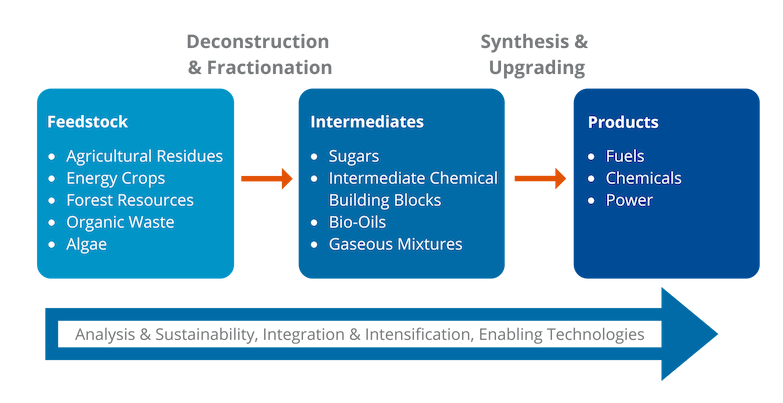Explain the Different Biomass Conversion Technologies
Biocatalysts such as enzymes in addition to heat and other chemicals to convert the carbohydrate portion of the biomass hemicellulose and cellulose into an intermediate sugar stream. I thermo-chemical conv ersion ii bio-chemical conversion and iii oil extraction.
_1509536705_19748-3.jpg)
Biomass Conversion Technologies Powerpoint Slides
Economic Issues of Biomass Energy.
_1509536705_19748-3.jpg)
. The idea is that by taking renewable supplies such as waste residues or managed forests we can create greener energy diminishing our reliance upon oil and reducing greenhouse gas emissions. Biomass conversion technologies for power and heat production are. Stabilisation of pyrolysis oils.
35 Detailed flow chart of various conversion processes used in bio-refinery is shown in Fig. Algae as feedstocks for bioenergy refers to a diverse group of highly productive organisms that include microalgae macroalgae seaweed and cyanobacteria formerly called blue-green algae. Biochemical conversion of biomass involves use of bacteria microorganisms and enzymes to breakdown biomass into gaseous or liquid fuels such as biogas or bioethanol.
Before the biomass is burnt they are needed to be dried. Biochemical processing- Biomass can also be converted into biofuels by. Renewable natural gasalso called biogas or biomethaneis produced in anaerobic digesters at sewage treatment plants and at dairy and livestock operations.
There are five fundamental forms of biomass energy use. Direct combustion co-firing pyrolysis torrefaction gasification anaerobic digestion and fermentation are discussed. The decomposition occurs at lower temperatures than gasification processes and produces liquid oil instead of a synthesis gas.
1 the traditional domestic use in developing countries fuelwood charcoal and agricultural residues for household cooking eg. The three stone fire lighting. These sugars are intermediate building blocks that can then be fermented or chemically catalyzed into a range of advanced biofuels and value-added chemicals.
Different approaches thermal conversion thermochemical conversion and biochemical conversion for conversion of biomass into useful forms of energy are presented in this chapter. The conversion technology of waste to energy involves the transformation of waste matter into numerous form of fuel that can be utilised to supply energy. In the recent years environmental-friendly exploitation and conversion of biomass waste into chemical fuels is considered as one of the effective approaches developing renewable energy.
Various conversion technologies have been used for effective conversion of biomass to biofuels such as thermochemical conversion biological conversion chemical conversion and physical conversion depending upon the required product. Biomass is an organic renewable energy sourceIt is used to create sustainable power. This includes wood food crops grass and woody plants agriculture and forestry residues and organic components of municipal and industrial wastes.
In pyrolysis processing biomass feedstocks are broken down using heat in the absence of oxygen producing a biooil that can be further refined to a hydrocarbon product. Crop residues waste residues wood debris and even algae are all. Within the gasification category specific technologies include fixed bed gasifiers and fluidized bed gasifiers.
Thermochemical processing- Processes such as gasification pyrolysis and liquefaction can be used for conversion of microalgal biomass to biofuels by use of thermal energy. BIOMASS CONVERSION TECHNOLOGIES There is wide verities of conversion technologies is available for manufacturing premium fuel from biomass 1. Biomass to Energy Conversion Technologies.
Many use sunlight and nutrients to create biomass which contains key componentsincluding lipids proteins and carbohydrates that can. What is Biomass. Bioethanol is used as a vehicle fuel.
Biomass is unique in that it can undergo different conversions and processes that produce different mediums like fuels materials and chemicals that can be used for energy and electricity in different ways. The most popular biochemical technologies are anaerobic digestion or biomethanation and fermentation. Biomass excludes organic material which has been transformed via.
Biomass conversion is a shared area between hydrogen production and biogas production. Fermentation converts biomass into bioethanol and anaerobic digestion converts biomass into renewable natural gas. Biomass products can be converted to biofuels to power vehicles heat homes power generators and machinery and other processes that would otherwise be.
It is similar to coal. Biomass conversion by hydrothermal liquefaction HTL and fast pyrolysis FP has. Anaerobic digestion is a series of chemical reactions during which organic.
In this process the biomass is heated to a temperature of 200 to 320ᴼC. The different processes of thermal conversion are direct firing pyrolysis co-firing gasification as well as anaerobic decomposition. Technologies for getting different products from biomass is broadly classified into three groups viz.
The chemical process of drying biomasses is called torrefaction. Biomass is a broad term used to describe any organic material or resource which is derived from plant or animal matter and primarily used as fuel. BIOMASS CONVERSION TECHNOLOGY Source- goog 32.
Within the direct-fired category specific technologies include stoker boilers fluidized bed boilers and cofiring. The Road to Commercialization examines biomass production biomass types properties and characterization and energy conversion technologies with an emphasis on the production of a gaseous fuel to supplement the gas derived from the landfilling of organic wastes landfill gas and used in gas engines to produce electricity. Oil extraction Text book- non-conventional renewable resources 31.

Flow Chart For Biomass Conversion And Solid Waste Conversion To Energy Download Scientific Diagram

Biomass Conversion Technologies

Biomass Gasification An Overview Of Technological Barriers And Socio Environmental Impact Intechopen
Comments
Post a Comment